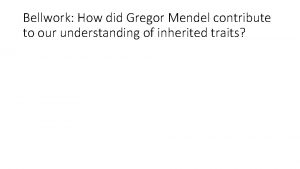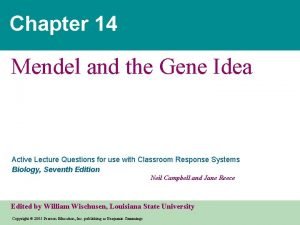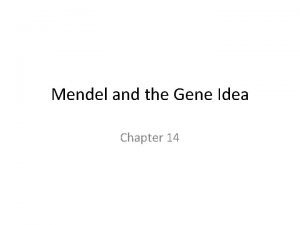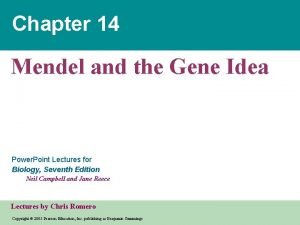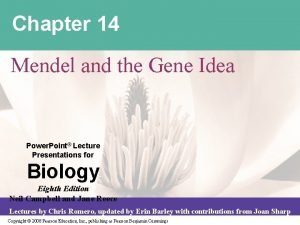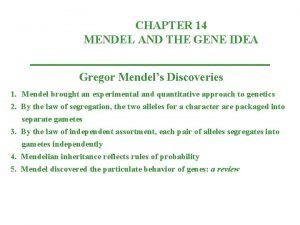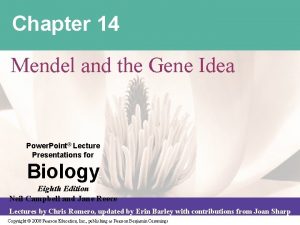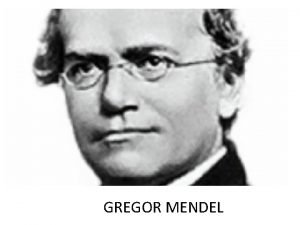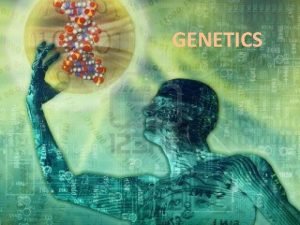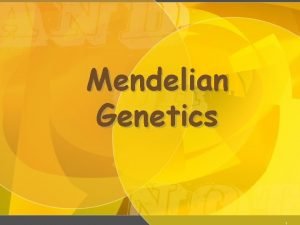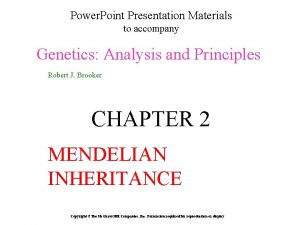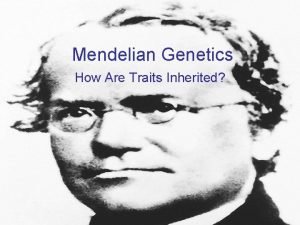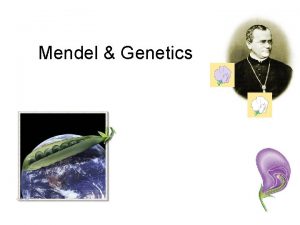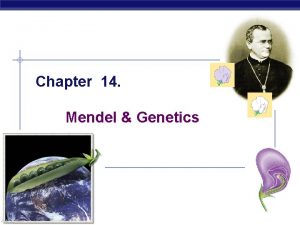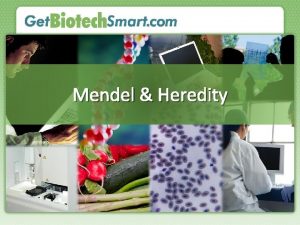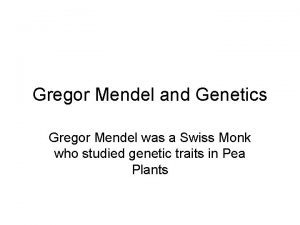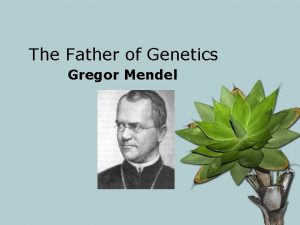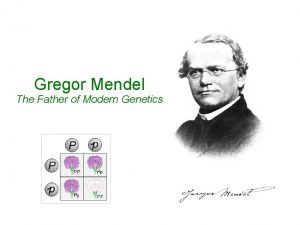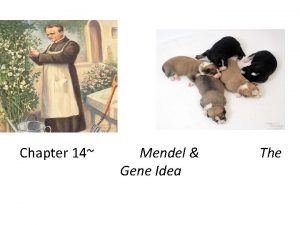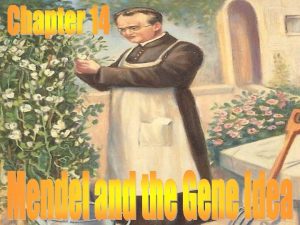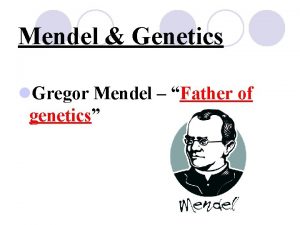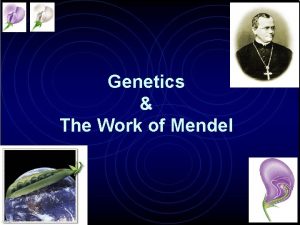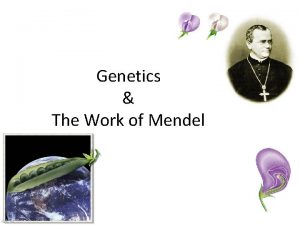Mendel The Gene Idea Gregor Mendel Modern genetics

















- Slides: 17

Mendel & The Gene Idea

Gregor Mendel • Modern genetics began in the mid 1800 s in an abbey garden, where a monk named Gregor Mendel documented inheritance in peas – used experimental method – used quantitative analysis • collected data & counted them – excellent example of scientific method

What did Mendel’s findings mean? • 1. ) Traits come in alternative forms – alleles • different alleles vary in the sequence of nucleotides at the specific locus of a gene – some difference in sequence of A, T, C, G purple-flower allele & white-flower allele are two DNA variations at flower-color locus different versions of gene at same location on homologous chromosomes

2. ) Traits are inherited as discrete units • For each characteristic, an organism inherits 2 alleles, 1 from each parent – diploid organism • inherits 2 sets of chromosomes, 1 from each parent

Mendel’s 1 st law of heredity • Law of segregation P PP – each allele for a trait is packaged into a separate gamete P p pp p P Pp p

Can you think of an exception to this? Mendel’s 2 nd law of heredity • Law of independent assortment – different loci (genes) separate into gametes independently yellow green round wrinkled Yy. Rr Yr Yr 1 y. R : y. R 1 YR : YR 1 yr : yr 1

Extending Mendelian genetics • Mendel worked with a simple system – peas are genetically simple – most traits are controlled by a single gene – each gene has only 2 alleles, 1 of which is completely dominant to the other • The relationship between genotype & phenotype is rarely that simple

Incomplete dominance (mix) • Heterozygote shows an intermediate, blended phenotype – example: • RR = red flowers • rr = white flowers • Rr = pink flowers – make 50% less color • Incomplete dominance in carnations: red, pink, white

Co-dominance (both) • 2 alleles affect the phenotype equally & separately – human ABO blood groups – Type AB blood

Multiple alleles: • more than 2 possible alleles for a gene. • Ex: human blood types

Pleiotropy: • genes with multiple phenotypic effect. • one gene affects more than one phenotypic character • Ex: sickle-cell anemia • Normal and sickle red blood cells

Pleiotropy • Most genes are pleiotropic – one gene affects more than one phenotypic character • 1 gene affects more than 1 trait • dwarfism (acgigantism (acromegaly) • hondroplasia)

Epistasis • One gene completely masks another gene – coat color in mice = 2 separate genes B_C_ bb. C_ _ _cc • C, c: pigment (C) or no pigment (c) • B, b: more pigment (black=B) or less (brown=b) • cc = albino, no matter B allele • 9: 3: 3: 1 becomes 9: 3: 4

Epistasis in Labrador retrievers • 2 genes: (E, e) & (B, b) – pigment (E) or no pigment (e) – pigment concentration: black (B) to brown (b) eebb ee. B– E–bb E–B–

Polygenic inheritance • Some phenotypes determined by additive effects of 2 or more genes on a single character – phenotypes on a continuum – human traits • • • skin color height weight intelligence behaviors

Human disorders • Testing: • amniocentesis • chorionic villus sampling (CVS) • Newer and safer techniques are being developed.

Genetic counseling • Pedigrees can help us understand the past & predict the future • Thousands of genetic disorders are inherited as simple recessive traits • • • albinism cystic fibrosis Tay sachs sickle cell anemia PKU
 Chapter 11 biology test
Chapter 11 biology test How did gregor mendel contribute to genetics
How did gregor mendel contribute to genetics Mendel monk
Mendel monk Chapter 14 mendel and the gene idea
Chapter 14 mendel and the gene idea Chapter 11 mendel and the gene idea
Chapter 11 mendel and the gene idea Mendel and the gene idea chapter 14
Mendel and the gene idea chapter 14 Mendel and the gene idea chapter 14
Mendel and the gene idea chapter 14 Chapter 14 mendel and the gene idea
Chapter 14 mendel and the gene idea Chapter 14 mendel and the gene idea
Chapter 14 mendel and the gene idea In the punnett square shown in figure 11-1
In the punnett square shown in figure 11-1 Mendel's law of independent assortment and segregation
Mendel's law of independent assortment and segregation Gregor mendel
Gregor mendel Conclusion gregor mendel
Conclusion gregor mendel Gregor mendel austrian monk
Gregor mendel austrian monk Mendel genetics
Mendel genetics Who is gregor mendel
Who is gregor mendel Gregor mendel laws
Gregor mendel laws Gregor mendel laws
Gregor mendel laws

